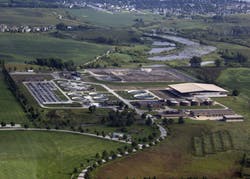Stanley Consultants has been awarded two Engineering Excellence awards for design of the wastewater treatment expansion at the South Plant in Iowa City, Iowa. The project received a National Recognition Award from the American Council of Engineering Companies (ACEC) and an Honor Award from ACEC – Iowa. Competitions held by the organization honor the year’s most outstanding engineering achievements.
The $50.2 million expansion is Iowa City’s largest public works project ever. Stanley Consultants, a global consulting engineering firm with several offices in Iowa, led the design team. The expansion took two years and included multiple process and equipment upgrades. The plant can now treat 24 million gal per day, double its previous capacity.
“The expansion design provides capacity for industrial growth and future population growth. We have phased conceptual designs that take us out another 30 years and beyond on the site so we know that our wastewater infrastructure will be capable of serving the needs of Iowa City for a long time,” said Iowa City Wastewater Division Superintendent Dave Elias.
This increase in capacity means that waste treatment formerly carried out at the aging North Plant, located near downtown Iowa City, can be diverted to the more modern South Plant. This move marks the culmination of a 40-year vision by the city to transfer all wastewater treatment operations out of the core of Iowa City. The flood-prone North Plant has been decommissioned and the site is being redeveloped into a 17-acre riverside park.
The diversion of all wastewater treatment operations to the South Plant necessitated the expansion but the project also included multiple process and equipment enhancements that improve efficiency, sustainability and safety. A unique Bio-Augmentation Reaeration (BAR) system, designed by Stanley Consultants and Brown and Caldwell, decreases the amount of tank space necessary for treatment and reduces the high concentrations of ammonia produced by the treatment process. Brown and Caldwell served as process engineering consultants on the project.
A new ultraviolet disinfection process replaced the chemical process that used chlorine gas and sulfur dioxide. Energy costs are reduced through the use of high-speed blowers, which more efficiently match process air requirements, as well as adjustments to the discharges of the influent pumps that reduce the overall pump lift required to move water into the treatment system.
For more than 25 years, Stanley Consultants has partnered with Iowa City on long-term planning and implementation of the city’s wastewater collection and treatment system to meet environmental stewardship objectives and accommodate city growth. Major assignments have included permitting and construction management of the original South, major trunk sewer extensions, and two major treatment plant upgrades.
Source: Stanley Consultants


